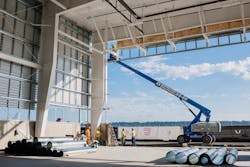While the notion of “if you build it, they will come” made for a great cinematic experience for baseball aficionados of the late '80s — it’s the wrong mindset for justifying a hangar development project. Building hangars on spec is fraught with consequences in the aviation field. Hence, in the previous article, a series of assumptions were introduced to ensure a new hangar development is a justified business decision for an FBO. Odd though it may seem, approaching those first steps with an attitude that a new hangar shouldn’t be built, ensures the right decision is made when the analysis to proceed — not gut instinct — indicates the timing is right.
With the market analysis complete and the decision to move forward made however, when in the process should an FBO select a design-build partner and create the pro forma? Asked the same question, Jon Wenrich, a corporate pilot, Airframe & Powerplant (A&P) mechanic and director of strategic partnerships for Centrex, a Western-US aviation-specialist design and construction management firm answers rhetorically, “When is the best time to buy an air conditioner? The winter of course. And the worst time? The summer. As consumers, we know that waiting until the last minute to make a significant purchase means we’ll end up paying a premium. Yet when it comes to building hangars, selecting a GC [general contractor] by putting the hangar build contract out to bid — after the architect and the civil and environmental engineers have all completed their work — is the equivalent of buying an air conditioner in the summer.” In short, and perhaps counterintuitively to some, selecting the design-build partner should be the first step in creation of the pro forma, not the last step.
Unfortunately, many begin the hangar development process ad hoc, and in the wrong order — by selecting a local architect. While selecting an architect as a first step seems logical, in large hangar development projects — generally those greater than 15,000 square feet — it is not. Only a handful of architects across the country truly understand the specialized nature of designing a hangar and the majority of architects an FBO may tap to design a hangar have never designed one. A dismissive “It can’t be any different than building a big box store — just with a large door” is an all-too-familiar refrain from well-meaning architects who’ve never designed hangars. Importantly, tenants will notice the difference on move in.
Returning to the pro forma, this is where the trouble starts. Virtually any architect can quote current build costs as a dollar per square foot number in their local area, but even then it’s secondhand information. These quotes are usually expressed as a range to account for contingencies. Additional assumptions, with an emphasis on the word assumptions, are thrown into the mix and soon, a completely inaccurate pro forma is the result because the right parties were not at the table when it was first created. Worse, these inaccuracies aren’t typically discovered by the FBO until the plans are finalized, submitted for permitting and put out to construction firms to bid.
Several cost areas should be considered in the pro forma, in addition to the design, engineering, and construction costs. Ideally, any improvement such as a hangar should be able to “stand alone” in terms of a return on investment. That is to say the “box” that is the hangar should produce more revenue than it cost to build it, plus the expenses to operate it over its service life. This means multiple factors should be in the pro forma, including but not limited to, demolition costs if an existing structure is on site, an apportioned amount of ground lease that the hangar occupies and related approach areas to, from, and surrounding the hangar, any leasehold taxes for the apportioned area, insurance, facility repair and maintenance during the hangar’s lifecycle, plus any cost of capital considerations such as pre-financing cash flow and loan amortization, if applicable. A percentage of the costs to build or maintain a fuel farm may also be considered, as a function of the total number of gallons expected to be produced by the mix of aircraft stored in said hangar, divided by the total gallons pumped by the FBO.
Though building a pro forma is a walk in the park for an experienced CFO, the assumptions used in one must come from multiple parties. The result can be like an orchestra without a conductor — a cacophony of noise that leaves all parties frustrated. Jimmy Severson, president of Centrex, advocates for a single, responsible party — a one-stop, design-build firm that is fluent in aviation, and most importantly, one willing to take responsibility. As a 7,000-hour airline transport pilot turned developer of aviation infrastructure projects, Severson’s fluency is immediately apparent.
Says Severson, “At Centrex, we refer to it as Build Plus. In practice, it means we act as the ‘center tent pole,’ the single point of contact, coordinator and responsible party for the architects, the civil engineers, subcontractors, and so on.” That center tent pole is the one ensuring those aforementioned parties are in the room to provide accurate input early on, when the pro forma is being built — not validate false assumptions after the pro forma is built.
In selecting a design-build firm, the most important factor to consider is also the most obvious: Has the selected partner actually designed and built a hangar before? If so, have they done so in the past five years? Wenrich makes an interesting, if not nuanced point on this matter. “Consider selecting an aviation company engaged in the design and construction of hangars, immersed in aviation as fellow consumers or clients, rather than a construction firm that happens to build hangars,” says Wenrich. For FBOs that do not have such firms in their local area, consider that the cost to bring a local firm up to speed on hangar design and construction puts a disproportionate and costly burden on the FBO to educate the selected partner. It distracts the FBO from the core business of running their business, and in the end costs more.
On that subject, while cost is always a factor, if choosing the traditional low-bid, wait-until-the-very-end-to-choose-a-general-contractor route, don’t be fooled by the lowest bid. In a low bid process, general contractors are not incentivized to provide the most realistic prices upfront, nor are the various subcontractors. This lack of incentive to provide realistic pricing is not as a result of any nefarious intent or deception, but rather, the result of the process set up for awarding the project. “As consumers ourselves, we tend toward ‘the insatiable desire for the lowest cost, but the lowest cost does not equal the highest value received,” adds Wenrich. As alluded to earlier, an inaccurate pro forma will further make the case for the FBO to select the lowest cost vendor — simply because it’s the one most closely matching the false assumptions. As the project matures however, the mistake of selecting the least expensive option is quickly laid bare — incremental costs begin to escalate, delays mount, and finger-pointing begins.
By that time, at least metaphorically, the FBO finds itself in a dysfunctional relationship it can’t exit — because to exit the relationship means progress grinds to a halt, and costs double when forced to start over. Sickeningly, a review of the original bids will only then reveal that the highest cost bid, the one not selected, was in fact accurate all along.
In summary, choose an expert firm at the beginning, involve them in developing the pro forma on day one, and the result is not only the best value, but often the lowest cost. In our next installment in this series, we’ll discuss techniques for securing tenant commitments for the to-be-built hangar, long before construction commences.






